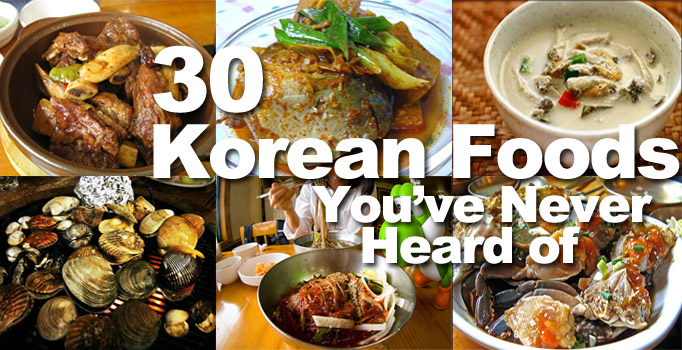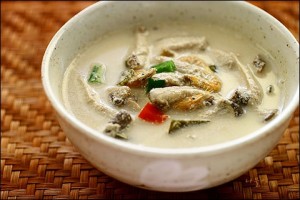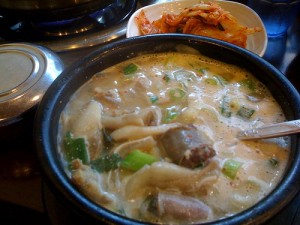30 Delicious Korean Foods You’ve (Probably) Never Heard Of
- agujjim
- altang
- andongjjimdalk
- bossam
- cheonggukjang
- daechanggui
- deulkketang
- galbi jjim
- galchijorim
- gamjaguk
- gamjatang
- ganjanggejang
- godeungeojorim
- golbaengi muchim
- gopchanggui
- gyeranjjim
- gyeranmari
- hobakjuk
- hoedeopbap
- jangjorim
- jjimdalk
- jjolmyeon
- jogaegui
- kimchimari guksu
- kongguksu
- kongnamulguk
- list of korean food
- maeuntang
- makguksu
- miyeokguk
- muguk
- nurungjitang
- someorigukbap
- suyuk
- where to eat in seoul
- yukhoe

Korean Stews/Soups
 16. Deulkkaetang (들깨탕) – perilla seed stew – This creamy and grainy soup is pretty hard to find even within Korea, but once you do find it, you’ll love the thick and grainy soup which is made from perilla seeds. Usually mushrooms or tofu are added to give you a bit more to chew on for this popular temple food (aka vegetarian friendly). Try hanging out with buddhists (or finding temple food restaurants in Seoul) to eat this dish. (Click here for image)
16. Deulkkaetang (들깨탕) – perilla seed stew – This creamy and grainy soup is pretty hard to find even within Korea, but once you do find it, you’ll love the thick and grainy soup which is made from perilla seeds. Usually mushrooms or tofu are added to give you a bit more to chew on for this popular temple food (aka vegetarian friendly). Try hanging out with buddhists (or finding temple food restaurants in Seoul) to eat this dish. (Click here for image)
17. Cheonggukjang (청국장) – fermented soy stew – Undoubtedly one of Korea’s smelliest foods, Cheonggukjang doesn’t get the publicity of other Korean foods. All Koreans eat doenjangjjigae (된장찌개), but not all Koreans enjoy its smelly cousin, cheonggukjang. But the ones that do, live and die by it! If you can get used to the smell, you’ll find yourself craving this awesome stew at the most random times (i.e. “man, that 2NE1 concert was awesome! Iunno why but I want some cheonggukjang now.” ;)). (Click here for image)
18. Maeuntang (매운탕) – Spicy soup – Although this dish can be a main dish, you might not have heard of it because it is also a common “left over” dish. You see, people usually order hoe (회), Korean style sashimi (raw fish), and use the leftover fish to make maeuntang. But don’t be fooled; this Korean food can be just as hearty with a bowl of rice. Find this at hoe restaurants nation wide!
19. Gamjatang (감자탕) – pork bone stew – This potato and pork combo is a spicy favorite for many Korean stew fans. Gamjatang restaurants aren’t so numerous abroad, but you’ll find these restaurants in every neighborhood in Korea. Usually sold in huge pots, this is a great communal dish for getting over a hangover or maybe even drinking a bottle or two to get a new one! Found everywhere in Korea. Really. (Click here for image)
20. Altang (알탕) – fish roe soup – If you’re a frequenter of local Korean bars, you may have heard of this soup. And although many Korean soups that are spicy may taste very similar, this one has a very distinct taste because of the hearty fish roe that infuses its flavors into the soup itself. Some restaurants outside of Korea may have this, but if not, try checking out a Korean bar. (Click here for image)
 21. Sundaeguk (순대국) – blood sausage soup – If you know anything about Korean street food, sundae is one of the staples of street food vendors. Move it into a restaurant and they’ll put the sundae in an awesome robust soup that’ll make you feel like a local Korean that’s eating a very Korean meal. Sundaeguk restaurants are also commonly found throughout Korea.
21. Sundaeguk (순대국) – blood sausage soup – If you know anything about Korean street food, sundae is one of the staples of street food vendors. Move it into a restaurant and they’ll put the sundae in an awesome robust soup that’ll make you feel like a local Korean that’s eating a very Korean meal. Sundaeguk restaurants are also commonly found throughout Korea.
22. Someorigukbap (소머리국밥) – ox head soup – Although there’s no ox head in your bowl (how silly would that be???), it’s traditionally made by boiling ox bones and an ox head in a big ol’ pot and adding some traditional medicinal herbs. Now, maybe no ox head (…maybe…), but this is one of those ultra hearty dishes that Korean ajeoshis love to eat and then let out a nice refreshing “kyaaaa!!!!” afterwards. (Click here for image)
→ Next Page





29 Comments
Actually gamjatang is not potato stew. Gamja stands for the cut of the meat not the potato itself.
Jesse that is incorrect, gamja means potato in korean, and tang means soup in korean. so gamja tang is appropriately potato soup/stew. please do not spread misinformation like that.
You’re right but, there is a theory you didn’t know.
Pig’s backbones, one of the main ingredient of ‘gamjatang’, was called ‘gamjappyeo’ or ‘gamjeo(甘猪)’ in the past. As you know, ‘gamjappyeo’ and ‘gamjeo’ are similar with ‘gamja’ in their pronunciation.
Han and Jesse are right. The original gamja tang did not contain potatoes and some places still don’t use potatoes.
Actually I knew of all of them. My favorite is gamjatang
http://www.youtube.com/watch?v=ejW_UtYdSss
Actually what Jesse said is true. The cut of the meat is actually called kamja. lol.
I am fluent in Korean and I am dating a Korean (3 years).
Ask a korean if you are not sure
Also, you can get kamjatang without potato in it =)
… Also it’s not 덥밥, it;s 덮밥. Sorry!
… 누룽지^ ㅠㅠ
You are correct! Edited to reflect your corrections. Thanks everyone! 🙂
It feels good to know that I have eaten as well as made majority of these delicious Korean food at home. Korean food is very healthy and because of that, I am able to maintain my top physical shape. ^^
Nice Chris, glad it’s keeping you healthy! You’re a K-food expert 🙂
http://lmgtfy.com/?q=%EA%B0%90%EC%9E%90
Erica, try again.
The 감자 in 감자탕 refers to the 감자뼈, which is the cut of meat that is in the dish. @J: Try again, look up 감자뼈.
Jesse, all you did was replace the word soup with the word bone. There are both potato (usually), and bone in that soup. This seems like a common misconception, and probably was the way it has been called for years (with or without the potato). (Much like how ramen means pulled noodles, even though they are rarely hand pulled now.) Though that doesn’t mean it is correct. In fact I went to eat this the other day and specifically asked the lady this question, she said gamja means potato. It doesn’t get much clearer than that.
Here’s another example: gamja jorim. Guess what? gamja is potato, and jorim is the cooking/prep method. Are you telling me gamja jorim is actually some sort of bone side dish? Seems like it isn’t.
The facts are that gamja means potato, and i’m not seeing any exception. Maybe there is an exception, but you haven’t show me. Please show me otherwise. Also, yes I can read korean.
Actually historians disagree on whether the 감자 in 감자탕 refers to potatoes or a particular part of the pig. So both theories could be true.
J, you do know that words can have several meanings, right? ^^ The most common meaning of 감자 is potato, but the part of the pig that is used in 감자탕 is commonly referred to as 감자뼈. Whether it was always called 감자뼈 is something historians can’t agree on. Some think that it took on the name 감자뼈 because it was always being used in 감자탕. No one knows for sure.
I am a Korean native speaker, for what it’s worth.
Yea I understand. I speak chinese as well and we often have simliar words/phrases, that can mean completely unrelated things, or the once-used-for-this-situation-now-always-used-regardless-of-logic words/phrases.
I guess calling it a potato bone because it’s commonly used in that dish seems pretty reasonable. I just hope people know that the actual bone used isn’t a “potato bone” but the 등뼈, and occasionally the 무릎뼈 and possibly others depending on the shop. The shop I frequent uses a lot of 무릎뼈.
I always eat the italian version of (육회) , carppaccio. I loove raw beef
korean usually eat page 3. #12 Makguksu (막국수) after eating Dakgalbi(Spicy Grilled Chicken) as main meal !! <3 so delicious ^.^
Why does Korean still eat raw beef? Japanese use to eat raw beef but then people die from eating it. The raw beef in Japan got ban for having on the menu. There no cure for raw beef if you get sick or about to die.
I feel so hungry now.. ^^
btw there are some mistakes. 김치마리국수 -> 김치말이국수, and 계란마리 -> 계란말이.
one question: What am I supposed to do, when I get a soup and one bowl of rice? I mean, shoud I put the rice into the soup, stir it ad then eat, or eat one spoon of the soup and then rice, one spoon of the soup and again rice?
hi guys, big fan of Seoulistic.com … recently saw a popular singapore blogger copying THIS PARTICULAR article wholesale without crediting. not sure what i should do, so just letting you know.
Hi thanks for letting me know! If you could email at [email protected] the specific blog. I don’t mind reposting, but would like to kindly ask for crediting 🙂
육회 너무 맛있어 보인다!!!
hmm I have heard off some off these and i love Yukhoe, sometimes at school i’ll just by raw beef and eat that during my lunchbreak even though my friends can’t stand it (most of them are vegans)lol
j, jessie, Shut up!!
Is it strange that I know all of these? They aren’t too uncommon.
Can someone please explain what the GAMJA means in GAMJAtang. It is still very unclear to me what this soup consist of. Maybe ask J and Jessie to help again? Ps. I am an English native speaker if that helps. Thanks ㅜㅜ ㅎㅎㅎㅎㅎ lolol